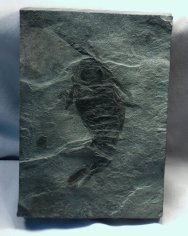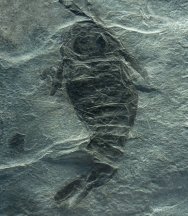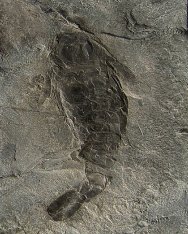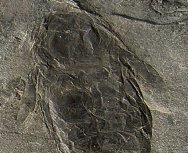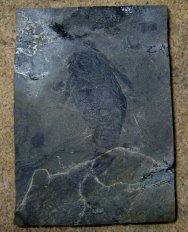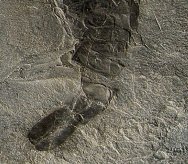Pterygootus
(Erettopterus) bilobus
Phylum Arthropoda,
Subphylum Chelicerata, Class Merostomata, Order Eurypterida, Family Pterygotidae
Geological
Time: Upper Silurian
Size (25.4
mm = 1 inch): Fossil is 125 mm long (curve measure) by 60 mm wide at
the swimming legs. Matrix: 175 mm by 125 mm.
Fossil Site:
Kip Burn Formation Leshmagow, Lanakshire, Scotland
Fossil Code:
UKF128
Price: Sold
| 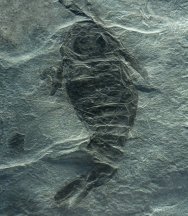 Description:
While Eurypterids (“Sea Scorpions”) are uncommon
fossils worldwide, New York state, Scotland, and the Kamenec-Podol’skij
Mine of the Ukraine are Description:
While Eurypterids (“Sea Scorpions”) are uncommon
fossils worldwide, New York state, Scotland, and the Kamenec-Podol’skij
Mine of the Ukraine are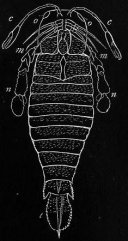 some of the few places where conditions
for preservation have been ideal. They were large arthropod predators
during the Silurian and Devonian, reaching a maximum length of
2.3 meters. The Eurypterids are thought to have been the first
creatures to conquer land, at least on a temporary basis. It
is presumed to have crawled along the seafloor, using its grasping
pincers to seize trilobites and other prey. This fine example
has the swimming paddles and one of the chelae(grasping appendages)
preserved. The specific name refers to the bilobed telson, preserved
here. Specimens such as this are no longer available, except
from old collections, as the are is now protected. This one was
professionally prepared in the United Kingdom. I have included
a photograph of it in the as found state so you can judge for
yourself the improvement quality preparation makes. some of the few places where conditions
for preservation have been ideal. They were large arthropod predators
during the Silurian and Devonian, reaching a maximum length of
2.3 meters. The Eurypterids are thought to have been the first
creatures to conquer land, at least on a temporary basis. It
is presumed to have crawled along the seafloor, using its grasping
pincers to seize trilobites and other prey. This fine example
has the swimming paddles and one of the chelae(grasping appendages)
preserved. The specific name refers to the bilobed telson, preserved
here. Specimens such as this are no longer available, except
from old collections, as the are is now protected. This one was
professionally prepared in the United Kingdom. I have included
a photograph of it in the as found state so you can judge for
yourself the improvement quality preparation makes.
|
|


